Discover 35 hidden attractions, cool sights, and unusual things to do in Dresden (Germany). Don't miss out on these must-see attractions: Gemäldegalerie Alte Meister, Schloss Pillnitz, and Mathematisch-Physikalischer Salon. Also, be sure to include Deutsches Hygiene-Museum in your itinerary.
Below, you can find the list of the most amazing places you should visit in Dresden (Saxony).
Table of Contents
Gemäldegalerie Alte Meister
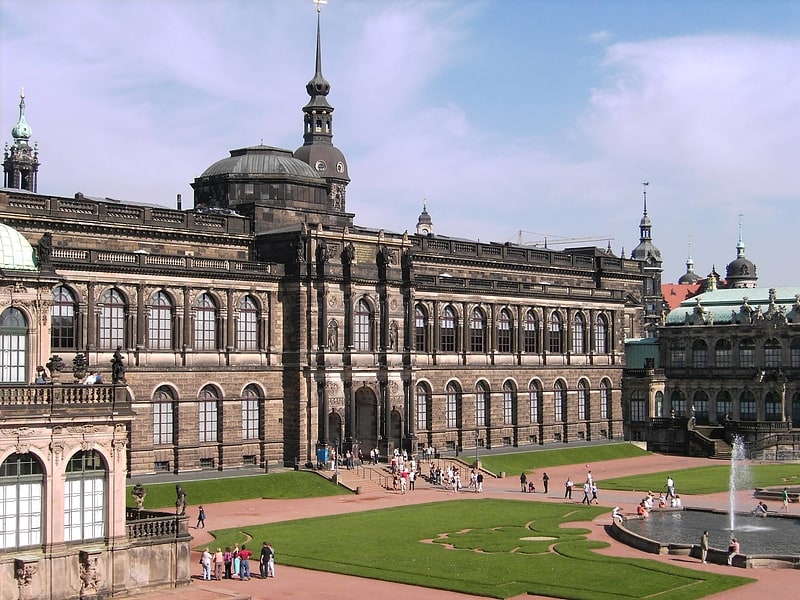
World-renowned collection of paintings. The Gemäldegalerie Alte Meister in Dresden, Germany, displays around 750 paintings from the 15th to the 18th centuries. It includes major Italian Renaissance works as well as Dutch and Flemish paintings. Outstanding works by German, French, and Spanish painters of the period are also among the gallery's attractions.
The Old Masters are part of the Dresden State Art Collections. The collection is located in the Semper Gallery, the gallery wing of the Zwinger.[1]
Address: Theaterplatz 1, 01067 Dresden (Altstadt)
Schloss Pillnitz
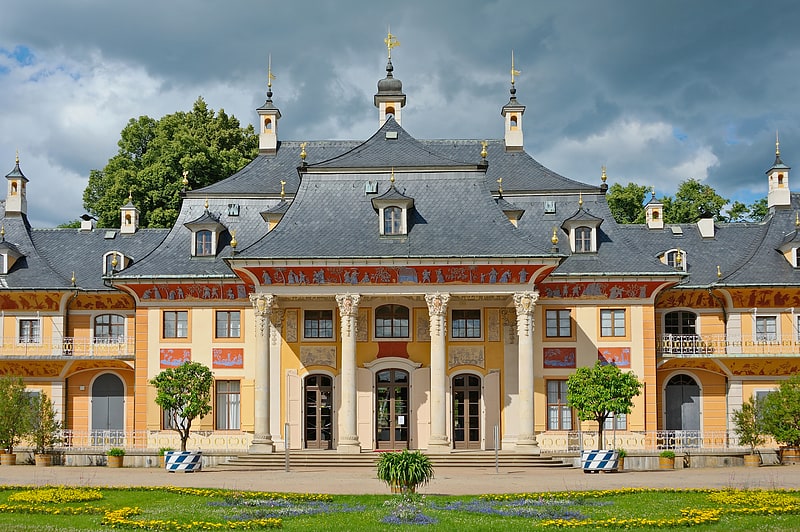
Restored renaissance palace with gardens. Pillnitz Palace is a restored Baroque schloss at the eastern end of the city of Dresden in the German state of Saxony. It is located on the bank of the River Elbe in the former village of Pillnitz. It was the summer residence of many electors and kings of Saxony; it is also known for the Declaration of Pillnitz in 1791.
The complex consists of three main buildings, the Riverside Palace (Wasserpalais) on the riverfront; the Upper Palace (Bergpalais) on the hillside, both Baroque with Chinoiserie elements; and the later Neoclassical New Palace (Neues Palais), which links them together on the east side. The buildings enclose a Baroque garden and are surrounded by a large public park.
Today, the buildings house the arts and crafts museum (Kunstgewerbemuseum) of the Dresden State Art Collections and a Schlossmuseum.[2]
Address: August-Böckstiegel-Straße 2, 01326 Dresden (Loschwitz)
Mathematisch-Physikalischer Salon
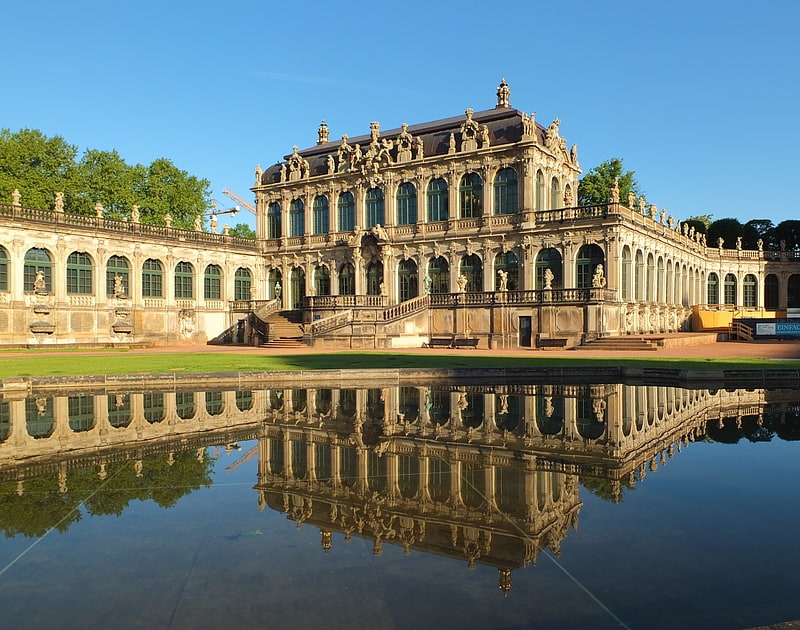
Scientific instrument and clock museum. The Mathematisch-Physikalischer Salon in Dresden, Germany, is a museum of historic clocks and scientific instruments. Its holdings include terrestrial and celestial globes, astronomical, optical and geodetic devices dating back to the 16th century, as well as historic instruments for calculating and drawing length, mass, temperature and air pressure.
The Mathematisch-Physikalischer Salon is part of the Staatliche Kunstsammlungen Dresden (State Art Collections). It is located in the Zwinger.[3]
Address: im Dresdener Zwinger, 01067 Dresden (Altstadt)
Deutsches Hygiene-Museum
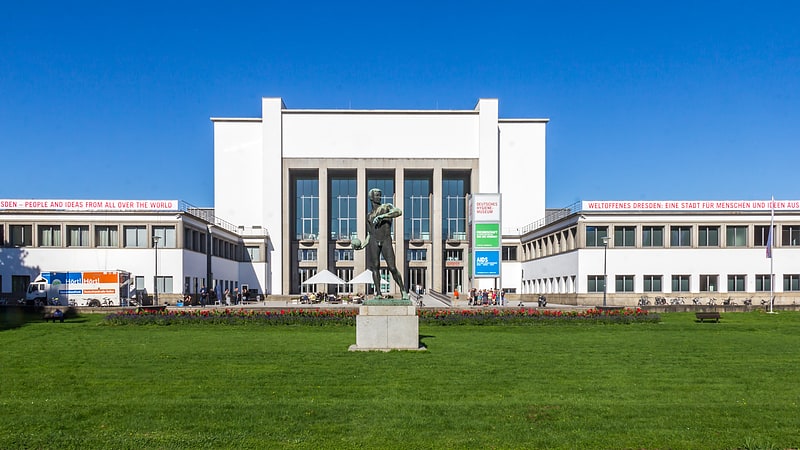
Museum in Dresden, Germany. The German Hygiene Museum is a medical museum in Dresden, Germany. It conceives itself today as a "forum for science, culture and society". It is a popular venue for events and exhibitions, and is among the most visited museums in Dresden, with around 280,000 visitors per year.[4]
Address: Lingnerpl. 1, 01069 Dresden (Altstadt)
Dresden Frauenkirche
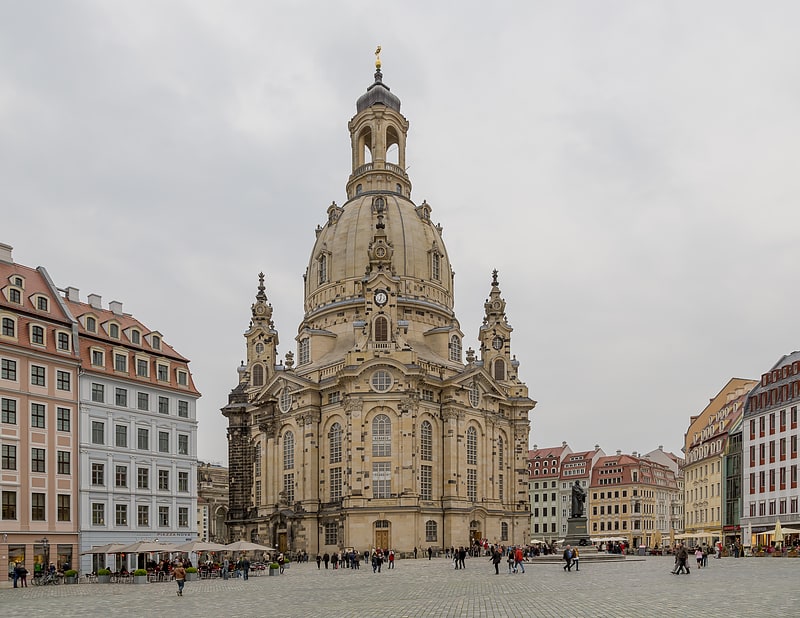
Also known as: Frauenkirche
Reconstructed Protestant church. The Dresden Frauenkirche is a Lutheran church in Dresden, the capital of the German state of Saxony. An earlier church building was Catholic until it became Protestant during the Reformation.
The old church was replaced in the 18th century by a larger Baroque Lutheran building. It is considered an outstanding example of Protestant sacred architecture, featuring one of the largest domes in Europe. It was originally built as a sign of the will of the citizens of Dresden to remain Protestant after their ruler had converted to Catholicism. It now also serves as a symbol of reconciliation between former warring enemies.
Built in the 18th century, the church was destroyed in the bombing of Dresden during World War II. The remaining ruins were left for 50 years as a war memorial, following decisions of local East German leaders. The church was rebuilt after the reunification of Germany, starting in 1994. The reconstruction of its exterior was completed in 2004, and the interior in 2005. The church was reconsecrated on 30 October 2005 with festive services lasting through the Protestant observance of Reformation Day on 31 October. The surrounding Neumarkt square with its many valuable baroque buildings was also reconstructed in 2004.
The Frauenkirche is often called a cathedral, but it is not the seat of a bishop; the church of the Landesbischof of the Evangelical-Lutheran Church of Saxony is the Church of the Cross. Once a month, an Anglican Evensong is held in English, by clergy from St. George's Anglican Church, Berlin.[5]
Address: Georg-Treu-Platz 3, 01067 Dresden (Altstadt)
Zwinger
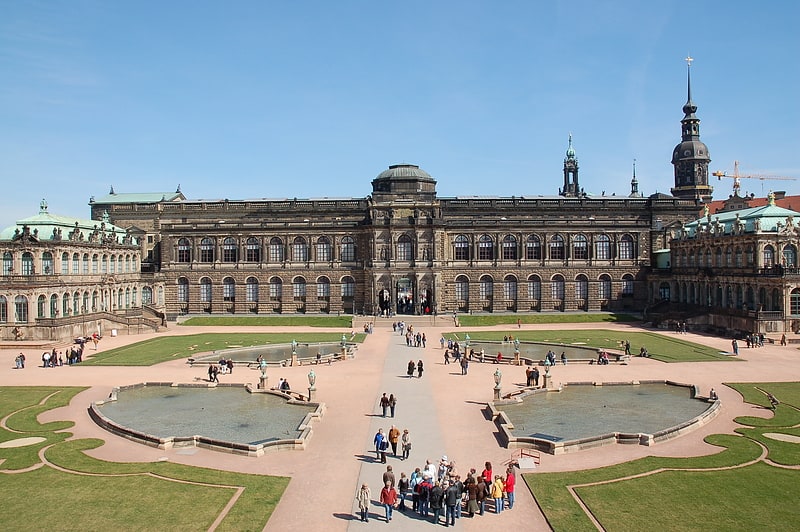
Grand building with gardens and galleries. The Zwinger is a palatial complex with gardens in Dresden, Germany. Designed by architect Matthäus Daniel Pöppelmann, it is one of the most important buildings of the Baroque period in Germany. Along with the Frauenkirche, the Zwinger is the most famous architectural monument of Dresden.
The name "Zwinger" goes back to the name used in the Middle Ages for a fortress part between the outer and inner fortress walls, even though the Zwinger no longer had a function corresponding to the name at the start of construction.
The Zwinger was built in 1709 as an orangery and garden as well as a representative festival area. Its richly decorated pavilions and the galleries lined with balustrades, figures and vases testify to the splendor during the reign of Augustus the Strong, Elector of Saxony and elected King of Poland. In the original conception of the elector, the Zwinger was the forecourt of a new castle that would take up the area between it and the Elbe; therefore, the Zwinger remained undeveloped on the Elbe side (provisionally closed with a wall). The plans for a new castle were abandoned after the death of Augustus the Strong, and with the departure from the Baroque period, the Zwinger initially lost importance. It was only over a century later that the architect Gottfried Semper completed it with the Semper Gallery towards the Elbe.
The Sempergalerie, opened in 1855, was one of the most important German museum projects of the 19th century and made it possible to expand the use of the Zwinger as a museum complex, which had grown under the influence of time since the 18th century. The Bombing of Dresden on February 13 and 14, 1945 hit the Zwinger extensively and led to extensive destruction. Since the reconstruction in the 1950s and 1960s, the Gemäldegalerie Alte Meister (Old Masters Picture Gallery), the Dresden Porcelain Collection (Dresdener Porzellansammlung) and the Mathematisch-Physikalischer Salon (Royal Cabinet of Mathematical and Physical Instruments). The original intended use as an orangery, garden and as a representative festival area has taken a back seat; the latter continues to be cultivated with the performance of music and theater events.[6]
Address: Theaterplatz 1, 01067 Dresden (Altstadt)
Semperoper
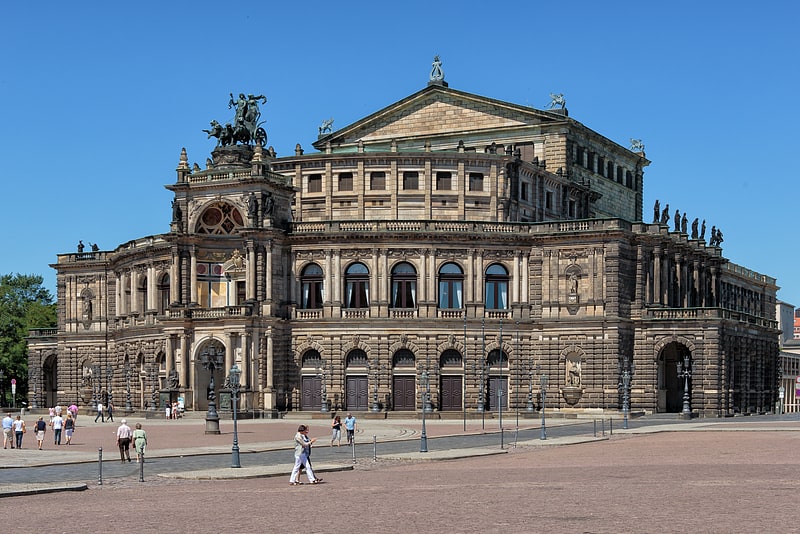
Lavish opera house rebuilt after a fire. The Semperoper is the opera house of the Sächsische Staatsoper Dresden and the concert hall of the Staatskapelle Dresden. It is also home to the Semperoper Ballett. The building is located on the Theaterplatz near the Elbe River in the historic centre of Dresden, Germany.
The opera house was originally built by the architect Gottfried Semper in 1841. After a devastating fire in 1869, the opera house was rebuilt, partly again by Semper, and completed in 1878. The opera house has a long history of premieres, including major works by Richard Wagner and Richard Strauss.[7]
Address: Theaterplatz 2, 01067 Dresden (Altstadt)
Bundeswehr Military History Museum

Also known as: Militärhistorisches Museum der Bundeswehr
Museum in Dresden, Germany. The Bundeswehr Military History Museum is the military museum of the German Armed Forces, the Bundeswehr, and one of the major military history museums in Germany. It is located in a former military arsenal in the Albertstadt which is part of Dresden. After a long history of switching titles and approaches to military history, the museum was re-opened in 2011 with a new internal and external concept. The museum focuses on the human aspects of war, while also showcasing the evolution of German military technology.[8]
Address: Olbrichtpl. 2, 01099 Dresden (Neustadt)
Galerie Neue Meister

Museum in Dresden, Germany. The Galerie Neue Meister in Dresden, Germany, displays around 300 paintings from the 19th century until today, including works from Otto Dix, Edgar Degas, Vincent van Gogh and Claude Monet. The gallery also exhibits a number of sculptures from the Dresden Sculpture Collection from the same period. The museum's collection grew out of the Old Masters Gallery, for which contemporary works were increasingly purchased after 1843.
The New Masters Gallery is part of the Staatliche Kunstsammlungen (State Art Collections) of Dresden. It is located in the Albertinum.[9]
Address: Theaterplatz 1, Dresden (Altstadt)
Dresden Castle

Also known as: Residenzschloss Dresden
Museum in Dresden, Germany. Dresden Castle or Royal Palace is one of the oldest buildings in Dresden, Germany. For almost 400 years, it was the residence of the electors and kings of Saxony from the Albertine House of Wettin as well as Kings of Poland. It is known for the different architectural styles employed, from Baroque to Neo-renaissance.
Today, the residential castle is a museum complex that contains the Historic and New Green Vault, the Numismatic Cabinet, the Collection of Prints, Drawings and Photographs and the Dresden Armory with the Turkish Chamber. It also houses an art library and the management of the Dresden State Art Collections.[10]
Address: Taschenberg 2, 01067 Dresden (Altstadt)
Dresden Cathedral
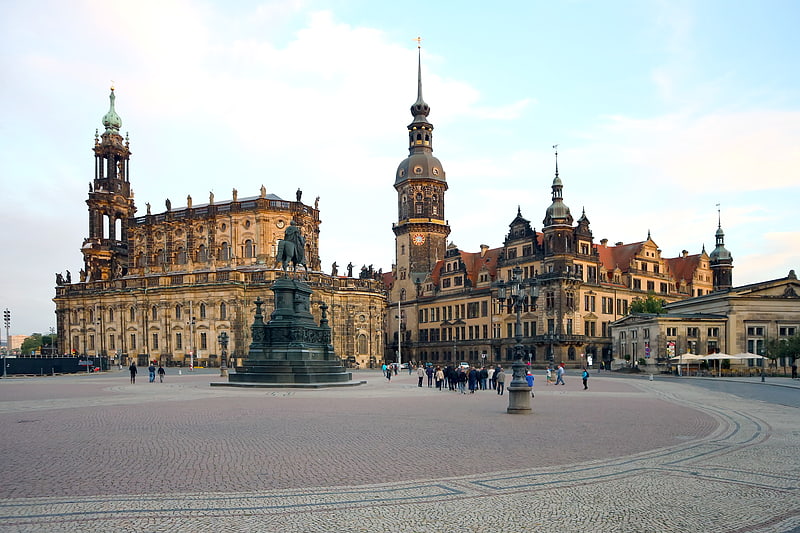
Also known as: Katholische Hofkirche
Roman Catholic cathedral of Dresden. Dresden Cathedral, or the Cathedral of the Holy Trinity, Dresden, previously the Catholic Church of the Royal Court of Saxony, called in German Katholische Hofkirche and since 1980 also known as Kathedrale Sanctissimae Trinitatis, is the Catholic Cathedral of Dresden.
Always the most important Catholic church of the city, it was elevated to the status of cathedral of the Roman Catholic Diocese of Dresden-Meissen in 1964. It is located near the Elbe river in the historic center of Dresden, Germany.
It is one of the burial sites of the House of Wettin, including Polish monarchs.[11]
Address: Schlossplatz 1, 01067 Dresden (Altstadt)
Porzellansammlung
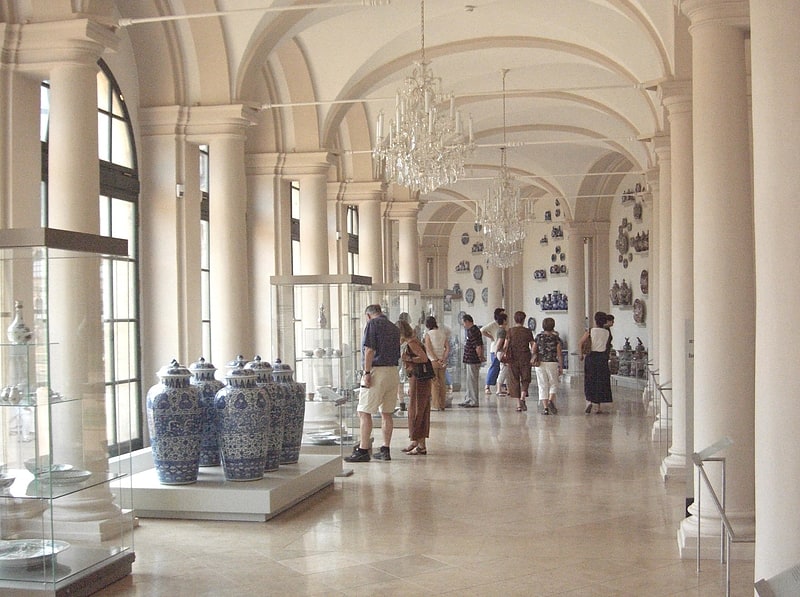
Porcelain collection at Zwinger Palace. The Dresden Porcelain Collection is part of the Staatliche Kunstsammlungen of Dresden, Germany. It is located in the Zwinger Palace.[12]
Address: Theaterplatz 1, 01067 Dresden (Altstadt)
Green Vault
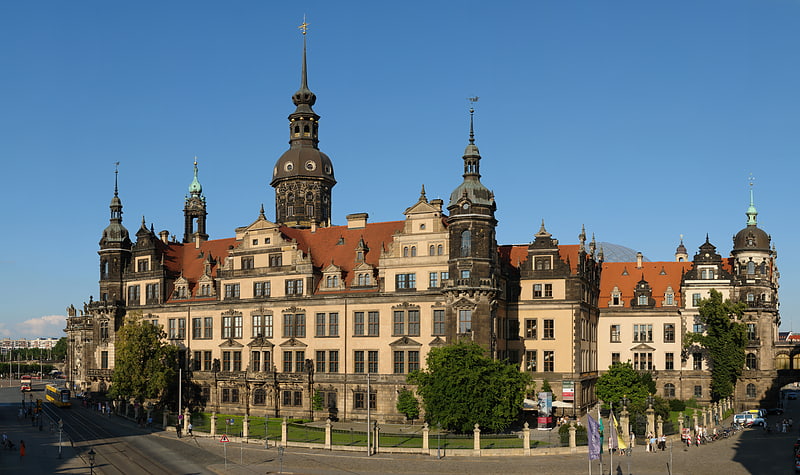
Also known as: Grünes Gewölbe
Museum with baroque jewelry and artworks. The Green Vault is a museum located in Dresden, Germany, which contains the largest treasure collection in Europe. The museum was founded in 1723 by Augustus the Strong of Poland and Saxony, and it features a variety of exhibits in styles from Baroque to Classicism. The Green Vault is named after the formerly malachite green painted column bases and capitals of the initial rooms. It has some claim to be the oldest museum in the world; it is older than the British Museum, opened in 1759, but the Vatican Museums date their foundation to the public display of the newly excavated Laocoön group in 1506.
After the bombing of Dresden during World War II, the Green Vault was completely restored. Today, its treasures are shown in two exhibitions: The Historic Green Vault (Historisches Grünes Gewölbe) is famous for its splendors of the historic treasure chamber as it existed in 1733, while the New Green Vault (Neues Grünes Gewölbe) focuses the attention on each individual object in neutral rooms.
The Green Vault is located on the first and second floors of the western section of Dresden Castle. It is now part of the Dresden State Art Collections.[13]
Address: Taschenberg 2, 01067 Dresden (Altstadt)
Kulturpalast
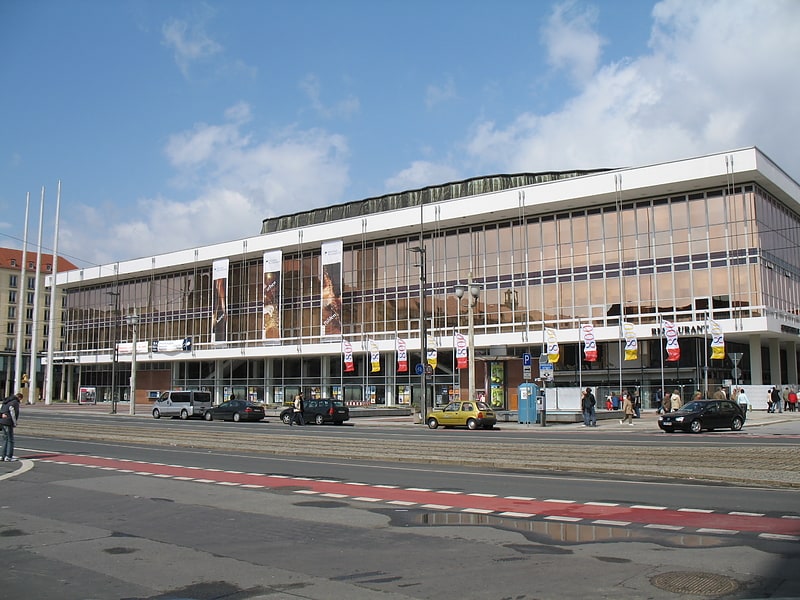
The Kulturpalast Dresden is a modernist building built by Wolfgang Hänsch during the era of the German Democratic Republic. It was the largest multi-purpose hall in Dresden when it opened in 1969, and was used for concerts, dances, conferences and other events. The building underwent several years of reconstruction beginning in 2012 and opened with a new concert hall in April 2017.
Unlike the other buildings in the Altmarkt square, the Kulturpalast is not designed in the unadorned International Style. It is a stand-alone building with a floorspace of around 600 square metres (6,500 sq ft). It faces Wilsdruffer Straße and forms the second part of the Altmarkt square. Located east of Schloßstraße and southwest of nearby Neumarkt, which has been undergoing a reconstruction project since 2005, it lies in the center of the historic old town, which was largely destroyed during the firebombing of Dresden on 13 February 1945.[14]
Address: Schlossstrasse 2, 01067 Dresden (Altstadt)
Dresden Zoo

Also known as: Zoo Dresden
Wildlife park with 2000 animals. Dresden Zoo or Zoo Dresden, is a zoo situated in the city of Dresden, Germany. It was opened in 1861, making it Germany's fourth oldest zoo. It was originally designed by Peter Joseph Lenné.
The zoo is located on the southern edge of the Großer Garten (Great Garden), a large city centre park. The zoo houses about 3000 animals of almost 400 species, especially Asian animals. It is a member of the World Association of Zoos and Aquariums (WAZA) and the European Association of Zoos and Aquaria (EAZA).
The zoo is served on its southern side by tram lines 9 and 13 of the Dresdner Verkehrsbetriebe, the local municipal transport company. On its northern side is the Zoo station of the Dresdner Parkeisenbahn, a minimum gauge railway through the Großer Garten that is largely operated by children.[15]
Address: Tiergartenstr. 1, 01219 Dresden (Altstadt)
Dresden Transport Museum
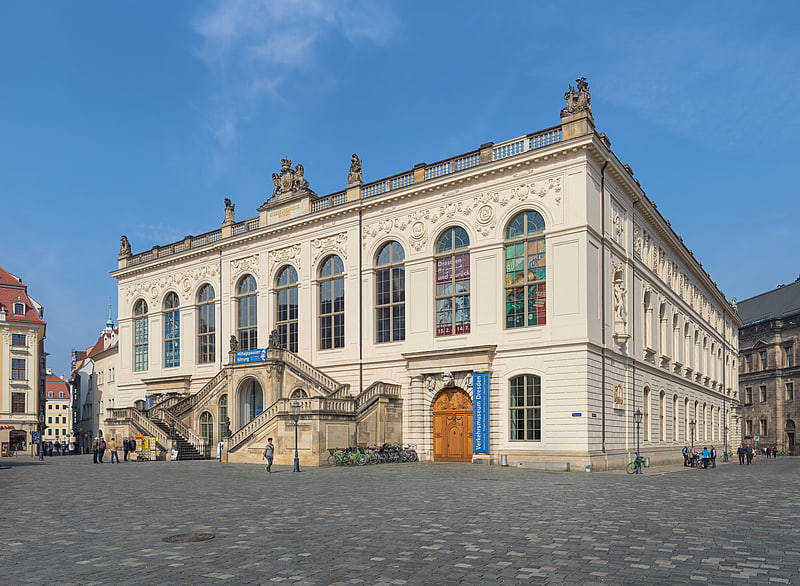
Also known as: Verkehrsmuseum Dresden
Museum in Dresden, Germany. The Dresden Transport Museum displays vehicles of all modes of transport, such as railway, shipping, road and air traffic, under one roof.
The museum is housed in the Johanneum at the Neumarkt in Dresden. The Johanneum was built between 1586 and 1590; it is one of the oldest museum buildings in Dresden.[16]
Address: Augustusstrasse 1, 01067 Dresden (Altstadt)
Augustusbrücke
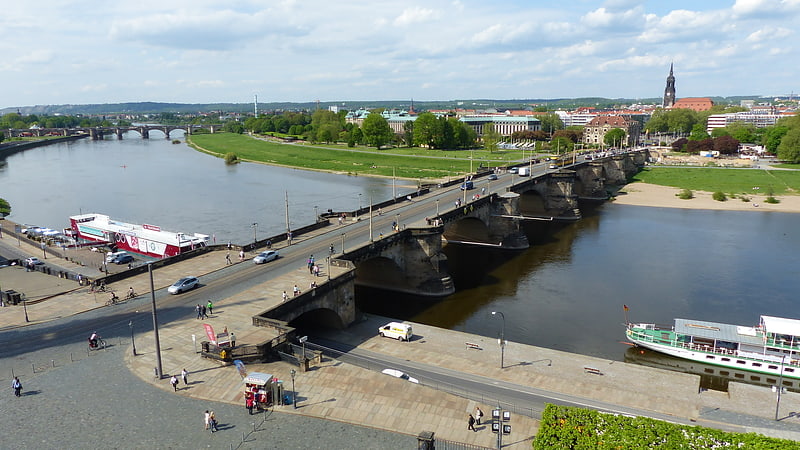
Early-1900s bridge over the Elbe. The Augustus Bridge is a bridge in the city of Dresden, in the state Saxony in Germany.
Crossing the river Elbe, the road bridge connects the Innere Neustadt in the north (right bank) with the historic city centre to the south (left bank).
There has been a bridge at the same location since at least the 12th century. Under king Augustus II the Strong of Poland and Saxony, a new sandstone bridge was built with 12 arches between 1727 and 1731. This bridge was replaced by the present, also sandstone, bridge with 9 arches in order to provide a wider opening for river traffic. It was designed by Wilhelm Kreis and Theodor Klette.
Three tram lines of the Dresdner Verkehrsbetriebe pass over the Augustus Bridge. All are currently (2019) diverted due to reconstruction works.
The current bridge was built between 1907 and 1910.[17]
Three Kings' Church

The Dreikönigskirche is a Lutheran church located in the Innere Neustadt of Dresden, Germany. It is the centre of a parish, and a community venue called Haus der Kirche. The church is a listed cultural monument of Dresden.
A church has been documented as standing at the site of the Dreikönigskirche since the 15th century. The present church was built from 1732 to 1739 with designs by Matthäus Daniel Pöppelmann and with George Bähr responsible for the interior features. The church was destroyed during the bombing of Dresden in World War II and not restored until the 1980s. It served as the seat of the state parliament of Saxony from 1990 to 1993.[18]
Address: Hauptstraße 23, 01097 Dresden (Neustadt)
Staatliche Kunstsammlungen Dresden

Cultural institute in Dresden, Germany. Staatliche Kunstsammlungen Dresden is a cultural institution in Dresden, Germany, owned by the State of Saxony. It is one of the most renowned and oldest museum institutions in the world, originating from the collections of the Saxon electors in the 16th century.
Today, the Dresden State Art Collections consists of fifteen museums. Most of them are located in the Dresden Castle, the Zwinger and the Albertinum.[19]
Address: Theaterplatz 1, 01067 Dresden (Altstadt)
Dresden Armoury
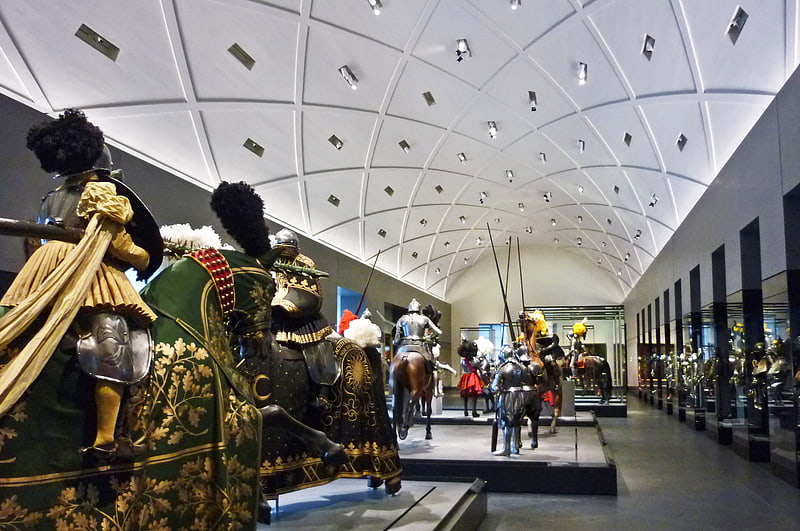
Also known as: Rüstkammer
Museum. The Dresden Armoury or Dresden Armory, also known as the Dresden Historical Museum, is one of the world's largest collections of ceremonial weapons, armour and historical textiles. It is part of the Dresden State Art Collections and is located in Dresden Castle in Dresden.
The Turkish Chamber (German: Türkische Kammer) is a separate collection within the Dresden Armoury that is focused on art from the Ottoman Empire.[20]
Address: Taschenberg 2, 01067 Dresden (Altstadt)
Kreuzkirche
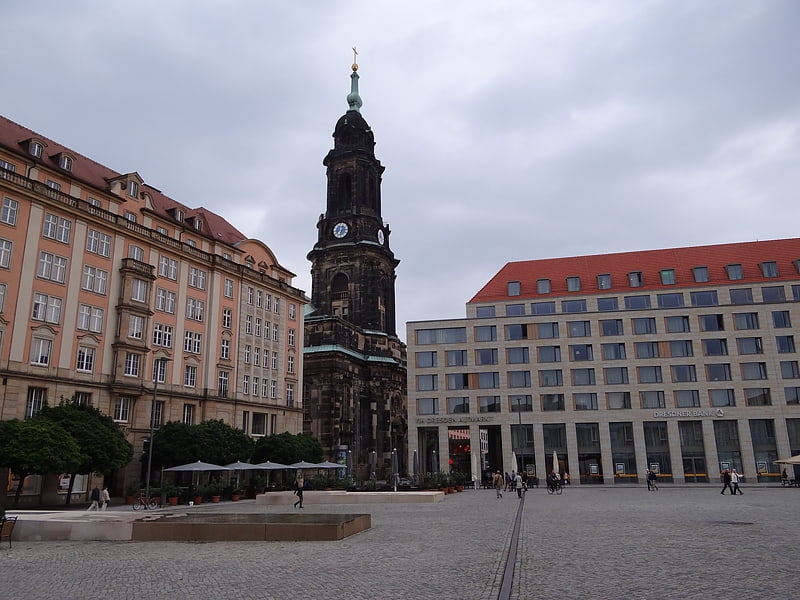
18th-century edifice with a 92m tower. The Dresden Kreuzkirche is a Lutheran church in Dresden, Germany. It is the main church and seat of the Landesbischof of the Evangelical-Lutheran Church of Saxony, and the largest church building in the Free State of Saxony. It also is home of the Dresdner Kreuzchor boys' choir.[21]
Address: An der Kreuzkirche 6, 01067 Dresden (Altstadt)
Schloßplatz
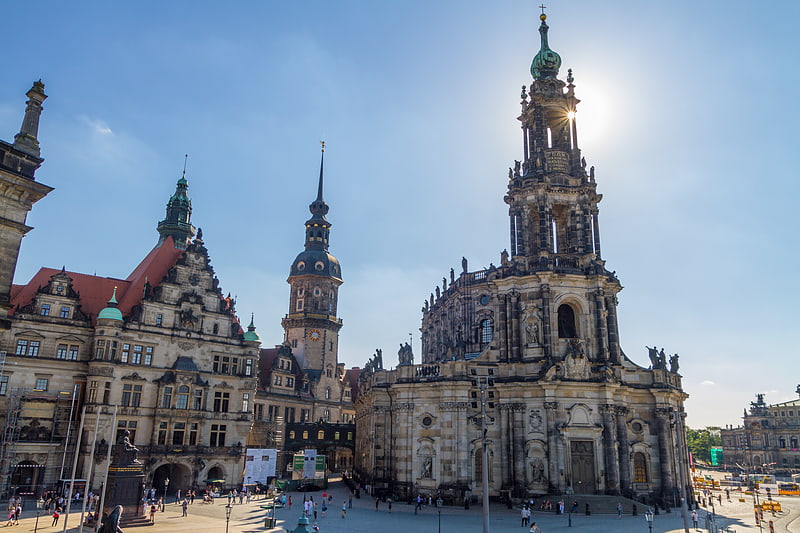
Historical landmark in Dresden, Germany. The Schloßplatz is a city square in the center of Dresden, Saxony, Germany. It gets its name from the Dresdner Schloss, the royal residence of the Electors and Kings of Saxony, which faces the south side of the square. The Schloßplatz is further bounded by the Katholische Hofkirche, the Sächsische Ständehaus, the Georgentor, and Augustus Bridge the over the River Elbe. Dating from the 15th century, the square was destroyed in Bombing of Dresden in World War II. In recent years the buildings surrounding the square have largely been restored so that the area again has a historic character.[22]
Japanisches Palais

Building in Dresden, Germany. The Japanisches Palais is a Baroque building in Dresden, Saxony, Germany. It is locate on the Neustadt bank of the river Elbe.[23]
Address: Grosse Meissner Strasse, Dresden (Neustadt)
Großer Garten

Vast garden with sculptures and a palace. The Großer Garten is a Baroque style park in central Dresden. It is rectangular in shape and covers about 1.8 km². Originally established in 1676 on the orders of John George III, Elector of Saxony, it has been a public garden since 1814. Pathways and avenues are arranged symmetrically throughout the park. The Sommerpalais, a small Lustschloss is at the center of the park.
Originally established outside the old walls of the city, the park was surrounded by urban areas by the second half of the 19th century. Dresden Zoo and Dresden Botanical Garden were added late in the 19th century. A miniature railway, known as the Parkeisenbahn, operates in the park from April to October.
Volkswagen's Transparent Factory is the newest building in the park, completed in 2002. It is on Straßburger Platz, in the northwest corner of the park.[24]
Address: Hauptallee 5, 01219 Dresden (Altstadt)
Neumarkt
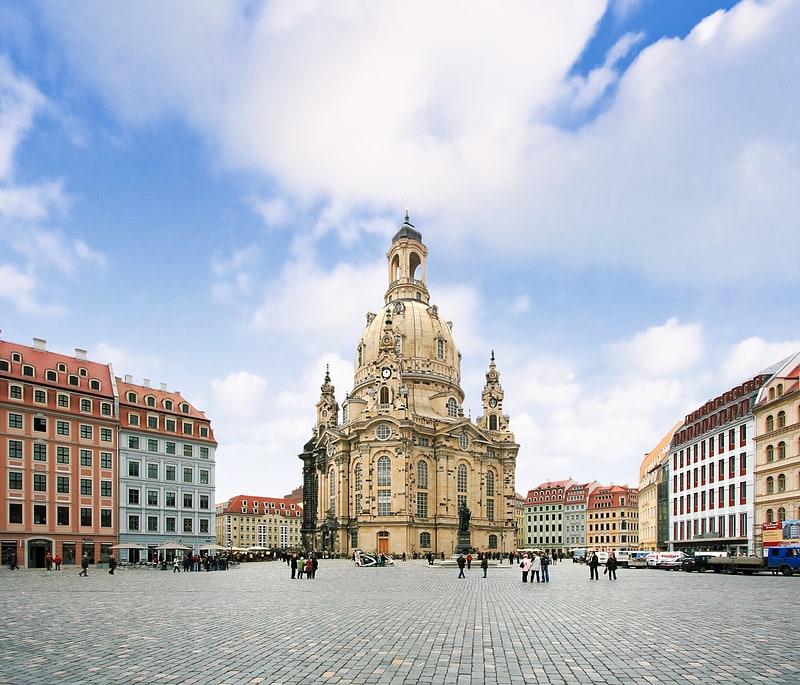
The Neumarkt in Dresden is a central and culturally significant section of central Dresden, Germany. The historic area was almost completely wiped out during the Allied bomb attack during the Second World War. After the war Dresden fell under Soviet occupation and later the communist German Democratic Republic which rebuilt the Neumarkt area in socialist realist style and partially with historic buildings. However huge areas and parcels of the place remained untilled. After the fall of Communism and German reunification the decision was made to restore the Neumarkt to its pre-war look.[25]
Münzkabinett
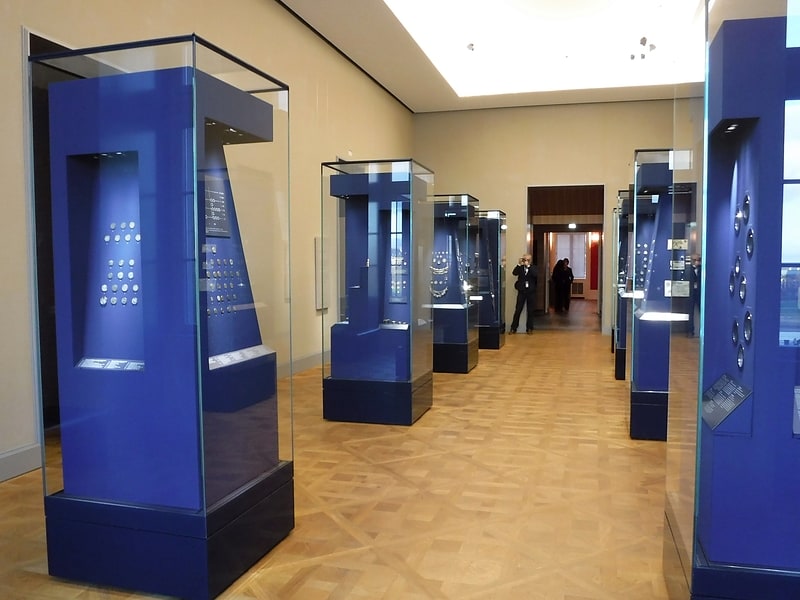
Museum in Dresden, Germany. The Münzkabinett is part of the Staatliche Kunstsammlungen Dresden. Founded around 1530, it is one of the oldest museums in Dresden. It is located in Dresden Castle.
The Münzkabinett is one of the three largest numismatic collections in Germany. Its nearly 300,000 objects include coins from most countries of the world from antiquity to present day, historic and modern medallions, medals and insignia, historic bank notes and bonds, minting dies for coins and medals, seals, models, early forms of money, and minting machines and equipment. The Münzkabinett is a Landesmünzkabinett or official state collection, and has claim to any hoards of coins found on Saxon territory.
The Münzkabinett is also a center of scholarly research and has a public library of some 30,000 volumes.[26]
Address: Taschenberg 2, 01067 Dresden (Altstadt)
Albrechtsberg Palace

Also known as: Schloss Albrechtsberg
Event space in 1800s mansion and gardens. Albrechtsberg Palace or Albrechtsberg Castle is a Neoclassical stately home above the Elbe river in the Loschwitz district of Dresden. It was erected in 1854 according to plans designed by the Prussian court and landscaping architect Adolf Lohse at the behest of Prince Albert, younger brother of the Prussian king Frederick William IV.[27]
Address: Bautzner Str. 130, 01099 Dresden (Loschwitz)
Sophienkirche
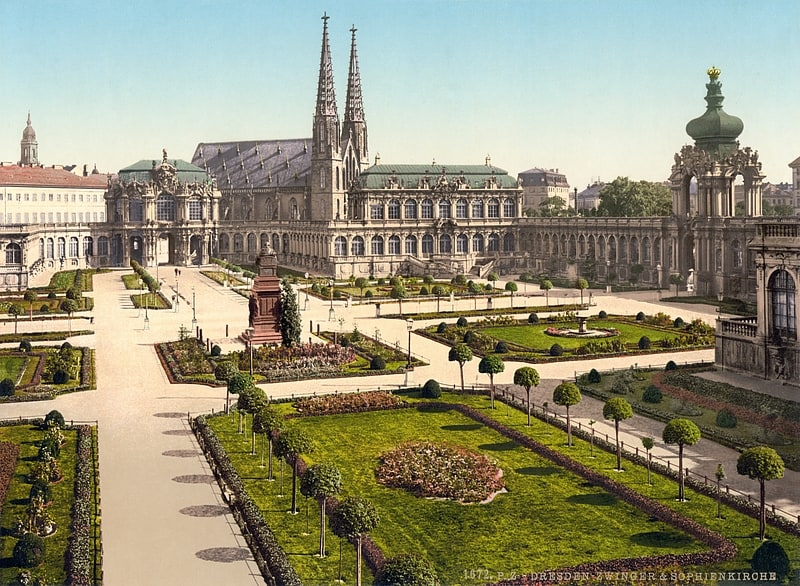
The Sophienkirche was a church in Dresden.
It was located on the northeast corner of the Postplatz (post office square) in the old town before it was severely damaged in the Dresden bombing in 1945 and subsequently destroyed in 1962 by the party and government of the GDR. It was the only Gothic church in the city.[28]
Transparent Factory

Also known as: Gläserne Manufaktur
Car factory in Dresden, Germany. The Transparent Factory is a car factory and exhibition space in Dresden, Germany owned by German carmaker Volkswagen and designed by architect Gunter Henn. It originally opened in 2002, producing the Volkswagen Phaeton until 2016. As of 2017 it produces the electric version of the Golf.[29]
Address: Lennestr. 1, 01069 Dresden (Altstadt)
Albertinum
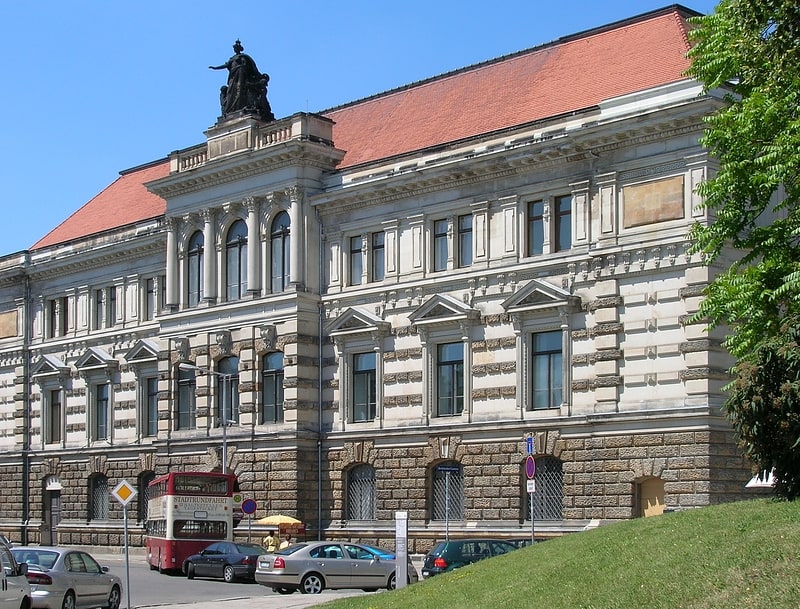
Art gallery with sculptures and paintings. The Albertinum is a modern art museum. The sandstone-clad Renaissance Revival building is located on Brühl's Terrace in the historic center of Dresden, Germany. It is named after King Albert of Saxony.
The Albertinum hosts the New Masters Gallery (Galerie Neue Meister) and the Sculpture Collection (Skulpturensammlung) of the Dresden State Art Collections. The museum presents both paintings and sculptures from Romanticism to the present, covering a period of some 200 years.[30]
Address: Tzschirnerpl. 2, 01067 Dresden (Altstadt)
St. Simeon of the Wonderful Mountain church

Also known as: Russisch-Orthodoxe Kirche
Church in Dresden, Germany. The St. Simeon of the Wonderful Mountain Church is a Russian Orthodox church in the German city of Dresden. It was designed by Harald Julius von Bosse and Karl Weißbach and built from 1872 to 1874. It is dedicated to Simeon Stylites the Younger.
During the aerial bombing attack on the city in February 1945, the church was the only building within a wide area which remained relatively intact.[31]
Address: Fritz-Löffler-Straße 19, 01069 Dresden (Plauen)
Yenidze

Office space rental agency in Dresden, Germany. Yenidze is a former cigarette factory building in Dresden, Saxony, Germany built between 1907 and 1909. Today it is used as an office building. It is notable for its Orientalizing exterior design which borrows design elements from mosques.
The Yenidze Tobacco and Cigarette Factory (German: Orientalische Tabak- und Zigarettenfabrik Yenidze) was a tobacco company started by the Jewish entrepreneur Hugo Zietz, which imported tobacco from Ottoman Yenidze, Thrace (modern Genisea, Greece). The "Oriental" style of architecture recalled the exotic origins of the Oriental tobaccos it processed and functioned as advertising for the firm. It has 600 windows of various styles; the dome is 20 metres (65') high.
The architect Martin Hammitzsch (the second husband of Angela Hitler) designed the building in 1907. It has large, colored dome chimneys which resemble minarets. It was sometimes referred to as the "tobacco mosque" (German: Tabakmoschee), a term which is no longer officially used as the building is not a mosque. It is a unique historical feature of the city of Dresden.
The building was restored in 1996 and is now an office building.[32]
Address: Weisseritzstr. 3, 01067 Dresden (Altstadt)
Carl Maria von Weber Museum
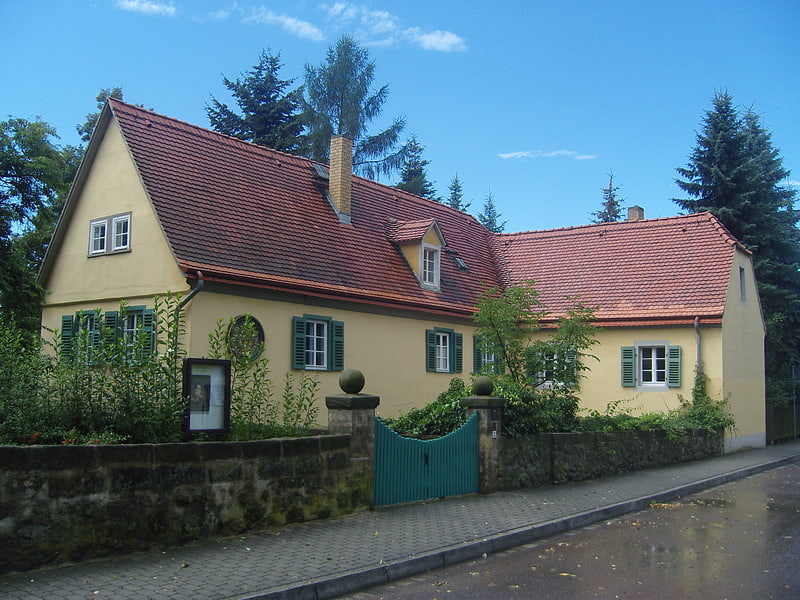
Museum in Dresden, Germany. The Carl Maria von Weber Museum is a cultural site in Dresden, in Saxony, Germany. The composer Carl Maria von Weber lived here during part of his career; the house is now a museum about his life and work.[33]
Address: Dresdner Str. 44, 01326 Dresden (Loschwitz)
DDV-Stadion
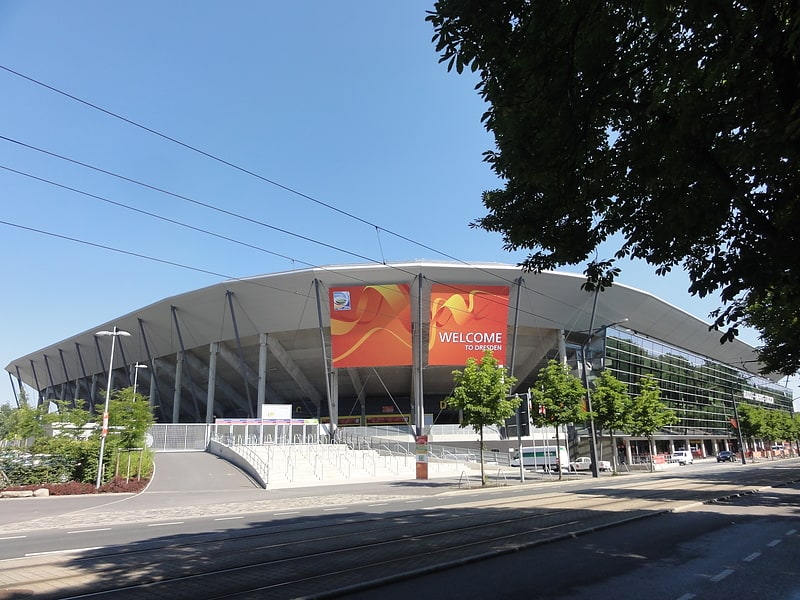
Also known as: Rudolf-Harbig-Stadion
Stadium in Dresden, Germany. Rudolf-Harbig-Stadion is a football stadium in Dresden, Saxony. It is named after German athlete Rudolf Harbig, and is the current home of Dynamo Dresden. Sports facilities have existed on the site of the stadium, the Güntzwiesen, since 1874. On 10 September 1911 the stadium hosted an international friendly match between Germany and Austria, which ended in a 1:2 defeat of host team Germany. The stadium also hosts events other than soccer games and has hosted several home games of the Dresden Monarchs American Football team of the German Football League, including their lone home appearance in the BIG6 European Football League in 2014.[34]
Address: Lennestr. 12, 01069 Dresden (Altstadt)
New Synagogue

Also known as: Neue Synagoge
Synagogue. The New Synagogue is a synagogue in the old town of Dresden, Germany. The edifice was completed in 2001 and designed by architects Rena Wandel-Hoefer and Wolfgang Lorch. It was built on the same location as the Semper Synagogue designed by Gottfried Semper, which was destroyed in 1938, during the Kristallnacht.
The boundary wall of the New Synagogue incorporates the last remaining fragments of Semper's original building. The outer walls of the synagogue are built slightly off plumb, intended by the architect to convey the feeling that the Jewish community has always been slightly set off from the German city. The synagogue is also a contrast to the city center with which it is juxtaposed. It is set on a slight rise just at the edge of Dresden's baroque center, which was completely flattened by allied bombing during the war. The center is being rebuilt with buildings whose exteriors are precise replicas of the baroque royal city that long made Dresden famous. The synagogue stands beside this careful reproduction of the past, but it is not a replica of the historic Semper Synagogue. It is a modernist statement that contrasts with its neighbors.
Inside, the sanctuary building is a cube Within this cube is set a square worship space, curtained off on all four sides by an enormous draping of curtains made of chain-mesh in a golden metal, evoking an echo of the scale of the Temple at Jerusalem.
The building was shortlisted by the jury for the European Union Prize for Contemporary Architecture in 2003.
On New Year's Eve in 2012, the mail box was broken at the entrance to the synagogue in Dresden and a blasphemous inscription was spray-painted on the external wall, which was interpreted as an anti-Semitic act.[35]
Address: Hasenberg 1, 01067 Dresden (Altstadt)